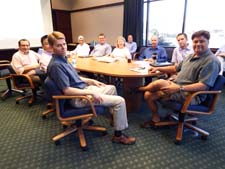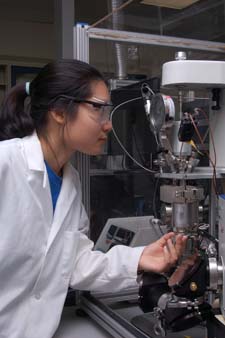KU receives $4.4M federal grant to design safer chemical manufacturing processes
LAWRENCE – Manmade chemicals are everywhere: in the clothes we wear, the cars we drive and nearly everything we use in daily life. Many of those chemicals, however, are derived from dwindling fossil-based sources and through processes that can be harmful to the environment.
 That could soon change. Researchers at the Center for Environmentally Beneficial Catalysis (CEBC) at the University of Kansas recently received a four-year, $4.4 million federal grant as part of the Networks for Sustainable Molecular Design and Synthesis program. It is one of only four such awards made this year by the National Science Foundation and the Environmental Protection Agency.
That could soon change. Researchers at the Center for Environmentally Beneficial Catalysis (CEBC) at the University of Kansas recently received a four-year, $4.4 million federal grant as part of the Networks for Sustainable Molecular Design and Synthesis program. It is one of only four such awards made this year by the National Science Foundation and the Environmental Protection Agency.
“Countless consumer products depend on synthetic plastics, fibers and foams,” said Bala Subramaniam, director of the CEBC and Dan F. Survey Distinguished Professor of Chemical and Petroleum Engineering. “One of the greatest challenges facing the chemical industry is to develop sustainable manufacturing processes that eliminate the use of hazardous materials, minimize waste, conserve resources and improve safety.”
 Reviewers of the CEBC grant proposal cited its innovative design approach. “In addition to traditional laboratory experiments, we will develop and use molecular-level computer modeling methods to understand and optimize different chemical processes,” said Brian Laird, professor of chemistry and lead investigator for the project. “The experimental and computational chemists will work in close collaboration to design manufacturing processes that are environmentally and economically superior to those in use today.”
Reviewers of the CEBC grant proposal cited its innovative design approach. “In addition to traditional laboratory experiments, we will develop and use molecular-level computer modeling methods to understand and optimize different chemical processes,” said Brian Laird, professor of chemistry and lead investigator for the project. “The experimental and computational chemists will work in close collaboration to design manufacturing processes that are environmentally and economically superior to those in use today.”
A major part of the project will be the identification of “hot spots” in the manufacturing chain that involve toxic materials or are prone to emitting waste. The CEBC research framework will be applied to two examples of high-volume chemical processes. One is a safer, phosgene-free route to dimethyl carbonate, an important solvent that, among many applications, is used in lithium ion batteries and has potential for use in the manufacture of polycarbonate plastics. The other process is a cleaner, more efficient route from butadiene to adipic acid, a commodity chemical used to make nylon.
“This is a great opportunity to use tools developed at the CEBC to bypass industrial hazards,” said Subramaniam. “With these tools and our existing state-of-the-art infrastructure, we’re in a position to make substantial progress toward tackling these problems almost immediately.”
In addition to Laird and Subramaniam, the CEBC team includes Raghunath Chaudhari, the Deane E. Ackers Distinguished Professor of Chemical and Petroleum Engineering, and Professors Ward Thompson and Jon Tunge in the Department of Chemistry. The project will support five graduate students, five postdoctoral researchers and several pre-service high school science teachers.
CEBC’s corporate partners in the project include Evonik, Invista, Archer Daniels Midland, Chevron Phillips Chemical Company Co. and Honeywell UOP. They will help guide the research toward commercialization. Discoveries emerging from the research could be especially beneficial to producers – in Kansas and elsewhere — of natural gas feedstocks used in the targeted manufacturing processes.
Laird says that the new discoveries and methodologies are likely to find broader impact in the design of other major chemical processes, such as those used in the production of pharmaceuticals. The work will also complement efforts under way at the CEBC to develop clean technologies for converting biomass into chemicals. That work is part of a $5.6 million grant awarded in 2011 by the U.S. Department of Agriculture.
“At a time when federal research funding is at risk from the budget sequester and other uncertainties, this grant speaks to the high quality of research being done at the CEBC,” said Steve Warren, vice chancellor for research and graduate studies. “This federal investment will have positive, far-reaching effects for Kansans and everyone else who uses products created from synthetic chemicals.”